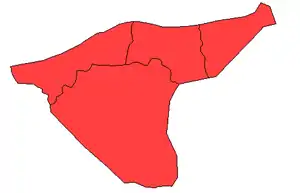Tell Brak
Tell Brak (Nagar, Nawar) was an ancient city in Syria; its remains constitute a tell located in the Upper Khabur region, near the modern village of Tell Brak, 50 kilometers north-east of Al-Hasaka city, Al-Hasakah Governorate. The city's original name is unknown. During the second half of the third millennium BC, the city was known as Nagar and later on, Nawar.
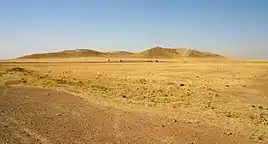 Tell Brak as seen from a distance with several excavation areas visible | |
 Shown within Near East  Tell Brak (Syria) | |
| Alternative name | Nagar, Nawar |
|---|---|
| Location | Al-Hasakah Governorate, Syria |
| Coordinates | 36°40′03.42″N 41°03′31.12″E |
| Type | Settlement |
| Area | 60 hectares (150 acres).[1] |
| Height | 40 metres (130 ft).[2] |
| History | |
| Periods | Neolithic, Bronze Age |
| Cultures | Halaf culture, Northern Ubaid, Uruk, Kish civilization, Hurrian |
| Site notes | |
| Excavation dates | 1937–1938, 1976–2011 |
| Archaeologists | Max Mallowan, David Oates, Joan Oates |
| Public access | yes |
| Website | tellbrak.mcdonald.cam.ac.uk |
Starting as a small settlement in the seventh millennium BC, Tell Brak evolved during the fourth millennium BC into one of the biggest cities in Upper Mesopotamia, and interacted with the cultures of southern Mesopotamia. The city shrank in size at the beginning of the third millennium BC with the end of Uruk period, before expanding again around c. 2600 BC, when it became known as Nagar, and was the capital of a regional kingdom that controlled the Khabur river valley. Nagar was destroyed around c. 2300 BC, and came under the rule of the Akkadian Empire, followed by a period of independence as a Hurrian city-state, before contracting at the beginning of the second millennium BC. Nagar prospered again by the 19th century BC, and came under the rule of different regional powers. In c. 1500 BC, Tell Brak was a center of Mitanni before being destroyed by Assyria c. 1300 BC. The city never regained its former importance, remaining as a small settlement, and abandoned at some points of its history, until disappearing from records during the early Abbasid era.
Different peoples inhabited the city, including the Halafians, Semites and the Hurrians. Tell Brak was a religious center from its earliest periods; its famous Eye Temple is unique in the Fertile Crescent, and its main deity, Belet Nagar, was revered in the entire Khabur region, making the city a pilgrimage site. The culture of Tell Brak was defined by the different civilizations that inhabited it, and it was famous for its glyptic style, equids and glass. When independent, the city was ruled by a local assembly or by a monarch. Tell Brak was a trade center due to its location between Anatolia, the Levant and southern Mesopotamia. It was excavated by Max Mallowan in 1937, then regularly by different teams between 1979 and 2011, when the work stopped due to the Syrian Civil War.
Name
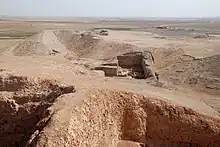
The original name of the city is unknown;[3] Tell Brak is the current name of the tell.[4] East of the mound lies a dried lake named "Khatuniah" which was recorded as "Lacus Beberaci" (the lake of Brak) in the Roman map Tabula Peutingeriana.[5] The lake was probably named after Tell Brak which was the nearest camp in the area.[6] The name "Brak" might therefore be an echo of the most ancient name.[5]
During the third millennium BC, the city was known as "Nagar", which might be of Semitic origin and mean a "cultivated place".[7] The name "Nagar" ceased occurring following the Old Babylonian period,[8][9] however, the city continued to exist as Nawar, under the control of Hurrian state of Mitanni.[10][11] Hurrian kings of Urkesh took the title "King of Urkesh and Nawar" in the third millennium BC; although there is general view that the third millennium BC Nawar is identical with Nagar,[12] some scholars, such as Jesper Eidem, doubt this.[13] Those scholars opt for a city closer to Urkesh which was also called Nawala/Nabula as the intended Nawar.[13]
History
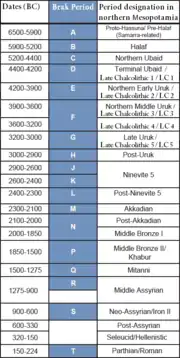
Early settlement
The earliest period A, is dated to the proto Halaf culture c. 6500 BC, when a small settlement existed.[14] Many objects dated to that period were discovered including the Halaf pottery.[15] By 5000 BC,[16] Halaf culture transformed into Northern Ubaid,[17] and many Ubaid materials were found in Tell Brak.[18] Excavations and surface survey of the site and its surroundings, unearthed a large platform of patzen bricks that dates to late Ubaid,[note 1][18] and revealed that Tell Brak developed as an urban center slightly earlier than better known cities of southern Mesopotamia, such as Uruk.[20][21]
The first city
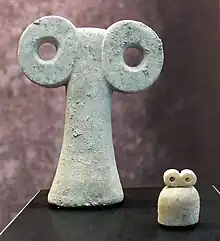
In southern Mesopotamia, the original Ubaid culture evolved into the Uruk period.[22] The people of the southern Uruk period used military and commercial means to expand the civilization.[23] In Northern Mesopotamia, the post Ubaid period is designated Late Chalcolithic / Northern Uruk period,[24] during which, Tell Brak started to expand.[18]
Period Brak E witnessed the building of the city's walls,[25] and Tell Brak expansion beyond the mound to form a lower town.[18] By the late 5th millennium BC, Tell Brak reached the size of c. 55 hectares.[26] Area TW of the tell (Archaeologists divided Tell Brak into areas designated with Alphabetic letters.[27] See the map for Tell Brak's areas) revealed the remains of a monumental building with two meters thick walls and a basalt threshold.[28] In front of the building, a sherd paved street was discovered, leading to the northern entrance of the city.[28] Area TW covered an area of nearly 600 square meters up to a depth of 10 meters.[29]
The city continued to expand during period F, and reached the size of 130 hectares.[30] Four mass graves, mainly sub-adults and young adults, dating to c. 3800–3600 BC were discovered in the submound, Tell Majnuna (built entirely of rubbish over two centuries), north of the main tell, and they suggest that the process of urbanization was accompanied by internal social stress, and an increase in the organization of warfare.[31] [32] The first half of period F (designated LC3), saw the erection of the Eye Temple,[note 2][30] which was named for the thousands of small alabaster "Eye idols" and "Spectacle-topped idols" figurines discovered in it.[note 3][38] Those idols were also found in area TW.[39]
Interactions with the Mesopotamian south grew during the second half of period F (designated LC4) c. 3600 BC,[40] and an Urukean colony was established in the city.[41][42] With the end of Uruk culture c 3000 BC, Tell Brak's Urukean colony was abandoned and deliberately leveled by its occupants.[43][44] Tell Brak contracted during the following periods H and J, and became limited to the mound.[45] Evidence exists for an interaction with the Mesopotamian south during period H, represented by the existence of materials similar to the ones produced during the southern Jemdet Nasr period.[46] The city remained a small settlement during the Ninevite 5 period, with a small temple and associated sealing activities.[note 4][45]
Kingdom of Nagar
Nagar | |
|---|---|
| c. 2600 BC–c. 2300 BC | |
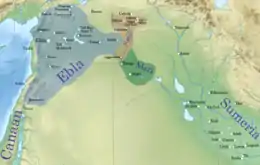 The kingdom of Nagar c. 2340 BC | |
| Capital | Nagar |
| Common languages | Nagarite |
| Religion | Mesopotamian |
| Government | Monarchy |
| Historical era | Bronze Age |
• Established | c. 2600 BC |
• Disestablished | c. 2300 BC |
Around c. 2600 BC, a large administrative building was built and the city expanded out of the tell again.[45] The revival is connected with the Kish civilization,[51] and the city was named "Nagar".[52] Amongst the important buildings dated to the kingdom, is an administrative building or temple named the "Brak Oval",[53] located in area TC.[54] The building have a curved exterior wall reminiscent of the Khafajah "Oval Temple" in central Mesopotamia.[55] However, aside from the wall, the comparison between the two buildings in terms of architecture is difficult, as each building follows a different plan.[56]
The oldest references to Nagar comes from Mari and tablets discovered at Nabada.[57] However, the most important source on Nagar come from the archives of Ebla.[58] Most of the texts record the ruler of Nagar using his title "En", without mentioning a name.[57][58] However a text from Ebla mentions Mara-Il, a king of Nagar;[57] thus, he is the only ruler known by name for pre-Akkadian Nagar and ruled a little more than a generation before the kingdom's destruction.[59]
At its height, Nagar encompassed most of the southwestern half of the Khabur Basin,[59] and was a diplomatic and political equal of the Eblaite and Mariote states.[60] The kingdom included at least 17 subordinate cities,[61] such as Hazna,[62] and most importantly Nabada, which was a city-state annexed by Nagar,[63] and served as a provincial capital.[64] Nagar was involved in the wide diplomatic network of Ebla,[51] and the relations between the two kingdoms involved both confrontations and alliances.[58] A text from Ebla mentions a victory of Ebla's king (perhaps Irkab-Damu) over Nagar.[58] However, a few years later, a treaty was concluded, and the relations progressed toward a dynastic marriage between princess Tagrish-Damu of Ebla, and prince Ultum-Huhu, Nagar's monarch's son.[7][58]
Nagar was defeated by Mari in year seven of the Eblaite vizier Ibrium's term, causing the blockage of trade routes between Ebla and southern Mesopotamia via upper Mesopotamia.[65] Later, Ebla's king Isar-Damu concluded an alliance with Nagar and Kish against Mari,[66] and the campaign was headed by the Eblaite vizier Ibbi-Sipish, who led the combined armies to victory in a battle near Terqa.[67] Afterwards, the alliance attacked the rebellious Eblaite vassal city of Armi.[68] Ebla was destroyed approximately three years after Terqa's battle,[69] and soon after, Nagar followed in c. 2300 BC.[70]Large parts of the city were burned, an act attributed either to Mari,[71] or Sargon of Akkad.[72]
Akkadian period

Following its destruction, Nagar was rebuilt by the Akkadian empire, to form a center of the provincial administration.[73] The city included the whole tell and a lower town at the southern edge of the mound.[52] Two public buildings were built during the early Akkadian periods, one complex in area SS,[73] and another in area FS.[74] The building of area FS included its own temple and might have served as a caravanserai, being located near the northern gate of the city.[75] The temple was dedicated to the god Šamagan, god of animals of the steppe.[76] The early Akkadian monarchs were occupied with internal conflicts,[77] and Tell Brak was temporarily abandoned by Akkad at some point preceding the reign of Naram-Sin.[note 5][80] The abandonment might be connected with an environmental event, that caused the desertification of the region.[80]
The destruction of Nagar's kingdom created a power vacuum in the Upper Khabur.[81] The Hurrians, formerly concentrated in Urkesh,[82] took advantage of the situation to control the region as early as Sargon's latter years.[81] Tell Brak was known as "Nawar" for the Hurrians,[83] and kings of Urkesh took the title "King of Urkesh and Nawar", first attested in the seal of Urkesh's king Atal-Shen.[12][84]
The use of the title continued during the reigns of Atal-Shen's successors, Tupkish and Tish-Atal,[82][85] who ruled only in Urkesh.[83] The Akkadians under Naram-Sin incorporated Nagar firmly into their empire.[86] The most important Akkadian building in the city is called the "Palace of Naram-Sin",[note 6][86] which had parts of it built over the original Eye Temple.[87][88] Despite its name, the palace is closer to a fortress,[86] as it was more of a fortified depot for the storage of collected tribute rather than a residential seat.[89][90] The palace was burned during Naram-Sin's reign, perhaps by a Lullubi attack,[72] and the city was burned toward the end of the Akkadian period c. 2193 BC, probably by the Gutians.[72]
Post-Akkadian kingdom
The Akkadian period was followed by period N,[91] during which Nagar was the center of an independent Hurrian dynasty,[92] evidenced by the discovery of a seal, recording the name of king Talpus-Atili of Nagar,[93] who ruled during or slightly after the reign of Naram-Sin's son Shar-Kali-Sharri.[94] The view that Tell Brak came under the control of Ur III is refused,[note 7][96] and evidence exists for a Hurrian rebuilding of Naram-Sin's palace, erroneously attributed by Max Mallowan to Ur-Nammu of Ur.[97] Period N saw a reduction in the city's size, with public buildings being abandoned, and the lower town evacuated.[98] Few short lived houses were built in area CH during period N,[98] and although greatly reduced in size, archaeology provided evidence for continued occupation in the city, instead of abandonment.[note 8][102]
Foreign rule and later periods
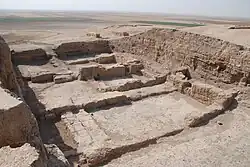
During period P, Nagar was densely populated in the northern ridge of the tell.[103] The city came under the rule of Mari,[104] and was the site of a decisive victory won by Yahdun-Lim of Mari over Shamshi-Adad I of Assyria.[105] Nagar lost its importance and came under the rule of Kahat in the 18th century BC.[9]
During period Q, Tell Brak was an important trade city in the Mitanni state.[106] A two-story palace was built c. 1500 BC in the northern section of the tell,[103][107] in addition to an associated temple.[108] However, the rest of the tell was not occupied, and a lower town extended to the north but is now all but destroyed through modern agriculture.[109] Two Mitannian legal documents, bearing the names of kings Artashumara and Tushratta, were recovered from the city,[110] which was destroyed between c.1300 and 1275 BC,[109] in two waves, first at the hands of the Assyrian king Adad-Nirari I, then by his successor Shalmaneser I.[111]
Little evidence of an occupation on the tell exists following the destruction of the Mitannian city, however, a series of small villages existed in the lower town during the Assyrian periods.[112] The remains of a Hellenistic settlement were discovered on a nearby satellite tell, to the northwestern edge of the main tell.[112] However, excavations recovered no ceramics of the Parthian-Roman or Byzantine-Sasanian periods, although sherds dating to those periods are noted.[112] In the middle of the first millennium AD, a fortified building was erected in the northeastern lower town.[112] The building was dated by Antoine Poidebard to the Justinian era (sixth century AD), on the basis of its architecture.[112] The last occupation period of the site was during the early Abbasid Caliphate's period,[113] when a canal was built to provide the town with water from the nearby Jaghjagh River.[112]
Society
People and language
The Halafians were the indigenous people of Neolithic northern Syria,[note 9][115] who later adopted the southern Ubaidian culture.[17] Contact with the Mesopotamian south increased during the early and middle Northern Uruk period,[33] and southern people moved to Tell Brak in the late Uruk period,[116] forming a colony, which produced a mixed society.[46] The Urukean colony was abandoned by the colonist toward the end of the fourth millennium BC, leaving the indigenous Tell Brak a much contracted city.[117][118] The pre-Akkadian kingdom's population was Semitic,[119] and spoke its own East Semitic dialect of the Eblaite language used in Ebla and Mari.[120] The Nagarite dialect is closer to the dialect of Mari rather than that of Ebla.[64]
No Hurrian names are recorded in the pre-Akkadian period,[77][121] although the name of prince Ultum-Huhu is difficult to understand as Semitic.[122] During the Akkadian period, both Semitic and Hurrian names were recorded,[74][119] as the Hurrians appear to have taken advantage of the power vacuum caused by the destruction of the pre-Akkadian kingdom, in order to migrate and expand in the region.[81] The post-Akkadian period Tell Brak had a strong Hurrian element,[123] and Hurrian named rulers,[119] although the region was also inhabited by Amorite tribes.[124] A number of the Amorite Banu-Yamina tribes settled the surroundings of Tell Brak during the reign of Zimri-Lim of Mari,[124] and each group used its own language (Hurrian and Amorite languages).[124] Tell Brak was a center of the Hurrian-Mitannian empire,[110] which had Hurrian as its official language.[125] However, Akkadian was the region's international language, evidenced by the post-Akkadian and Mitannian eras tablets,[126][127] discovered at Tell Brak and written in Akkadian.[128]
Religion
The findings in the Eye Temple indicate that Tell Brak is among the earliest sites of organized religion in northern Mesopotamia.[129] It is unknown to which deity the Eye Temple was dedicated,[3] and the "Eyes" figurines appears to be votive offerings to that unknown deity.[33] The temple was probably dedicated for the Sumerian Innana or the Semitic Ishtar; Michel Meslin hypothesized that the "Eyes" figurines were a representation of an all-seeing female deity.[130]
During the pre-Akkadian kingdom's era, Hazna, an old cultic center of northern Syria, served as a pilgrimage center for Nagar.[131] The Eye Temple remained in use,[132] but as a small shrine,[133] while the goddess Belet Nagar became the kingdom's paramount deity.[note 10][132] The temple of Belet Nagar is not identified but probably lies beneath the Mitannian palace.[103] The Eblaite deity Kura was also venerated in Nagar,[122] and the monarchs are attested visiting the temple of the Semitic deity Dagon in Tuttul.[58] During the Akkadian period, the temple in area FS was dedicated to the Sumerian god Shakkan, the patron of animals and countrysides.[75][136][137] Tell Brak was an important religious Hurrian center,[138] and the temple of Belet Nagar retained its cultic importance in the entire region until the early second millennium BC.[note 11][7]
Culture

Northern Mesopotamia evolved independently from the south during the Late Chalcolithic / early and middle Northern Uruk (4000–3500 BC).[41] This period was characterized by a strong emphasis on holy sites,[140] among which, the Eye Temple was the most important in Tell Brak.[141] The building containing "Eyes" idols in area TW was wood paneled, whose main room had been lined with wooden panels.[30] The building also contained the earliest known semi columned facade, which is a character that will be associated with temples in later periods.[30]
By late Northern Uruk and especially after 3200 BC, northern Mesopotamia came under the full cultural dominance of the southern Uruk culture,[41] which affected Tell Brak's architecture and administration.[116] The southern influence is most obvious in the level named the "Latest Jemdet Nasr" of the Eye Temple,[35] which had southern elements such as cone mosaics.[142] The Uruk presence was peaceful as it is first noted in the context of feasting; commercial deals during that period were traditionally ratified through feasting.[note 12][116][143] The excavations in area TW revealed feasting to be an important local habit, as two cooking facilities, large amounts of grains, skeletons of animals, a domed backing oven and barbequing fire pits were discovered.[144] Among the late Uruk materials found at Tell Brak is a standard text for educated scribes (the "Standard Professions" text), part of the standardized education taught in the 3rd millennium BC over a wide area of Syria and Mesopotamia.[145]
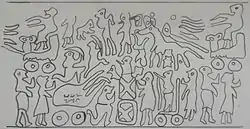
The pre-Akkadian kingdom was famed for its acrobats, who were in demand in Ebla and trained local Eblaite entertainers.[59] The kingdom also had its own local glyptic style called the "Brak Style",[146] which was distinct from the southern sealing variants, employing soft circled shapes and sharpened edges.[147] The Akkadian administration had little effect on the local administrative traditions and sealing style,[148] and Akkadian seals existed side by side with the local variant.[149] The Hurrians employed the Akkadian style in their seals, and Elamite seals were discovered, indicating an interaction with the western Iranian Plateau.[149]
Tell Brak provided great knowledge on the culture of Mitanni, which produced glass using sophisticated techniques, that resulted in different varieties of multicolored and decorated shapes.[110] Samples of the elaborate Nuzi ware were discovered, in addition to seals that combine distinctive Mitannian elements with the international motifs of that period.[110]
Prior to the Nuzi ware, the predominant ceramic tradition at Brak is known as Khabur ware. Nuzi ware retains some shapes of Khabur ware, as well as some of its surface decorations. The fourth and last phase of Khabur ware (around 1500 BC) is generally contemporaneous with Nuzi ware. Both of them occur in parallel for some time at Brak before the Khabur ware disappears.[150]
Wagons
Seals from Tell Brak and Nabada dated to the pre-Akkadian kingdom, revealed the use of four-wheeled wagons and war carriages.[151] Excavation in area FS recovered clay models of equids and wagons dated to the Akkadian and post-Akkadian periods.[151] The models provide information about the types of wagons used during that period (2350–2000 BC),[152] and they include four wheeled vehicles and two types of two wheeled vehicles; the first is a cart with fixed seats and the second is a cart where the driver stands above the axle.[106] The chariots were introduced during the Mitanni era,[106] and none of the pre-Mitanni carriages can be considered chariots, as they are mistakenly described in some sources.[106][152]
Government
The first city had the characteristics of large urban centers, such as monumental buildings,[153] and seems to have been ruled by a kinship based assembly, headed by elders.[154] The pre-Akkadian kingdom was decentralized,[155] and the provincial center of Nabada was ruled by a council of elders, next to the king's representative.[156] The Nagarite monarchs had to tour their kingdom regularly in order to assert their political control.[155][157] During the early Akkadian period, Nagar was administrated by local officials.[74] However, central control was tightened and the number of Akkadian officials increased, following the supposed environmental event that preceded the construction of Naram-Sin's palace.[108] The post-Akkadian Nagar was a city-state kingdom,[158] that gradually lost its political importance during the early second millennium BC, as no evidence for a king dating to that period exists.[105]
Rulers of Tell Brak
| King | Reign | Notes |
|---|---|---|
| Early period, possibly ruled by a local assembly of elders.[154] | ||
| Pre-Akkadian kingdom of Nagar (c. 2600–2300 BC) | ||
| Mara-Il | Fl. late 24th century BC.[59] | |
| Early Akkadian period, early 23rd century BC.[73] | ||
| Urkesh dominance, the Urkeshite king Atal-Shen styled himself "King of Urkesh and Nawar",[159] so did his successors who ruled only in Urkesh.[83] | ||
| Akkadian control, under the rule of Naram-Sin of Akkad.[86] | ||
| Post-Akkadian kingdom of Nagar | ||
| Talpus-Atili | Fl. end of the third millennium BC.[160] | Styled himself "the sun of the country of Nagar".[81] |
| Various foreign rulers such as Mari,[104] Kahat,[9] Mitanni,[106] and Assyria.[161] | ||
Economy
Throughout its history, Tell Brak was an important trade center; it was an entrepot of obsidian trade during the Chalcolithic, as it was situated on the river crossing between Anatolia, the Levant and southern Mesopotamia.[162] The countryside was occupied by smaller towns, villages and hamlets, but the city's surroundings were empty within three kilometers.[40] This was probably due to the intensive cultivation in the immediate hinterland, in order to sustain the population.[40] The city manufactured different objects, including chalices made of obsidian and white marble,[31] faience,[163] flint tools and shell inlays.[164] However, evidence exists for a slight shift in production of goods toward manufacturing objects desired in the south, following the establishment of the Uruk colony.[116]
Trade was also an important economic activity for the pre-Akkadian kingdom of Nagar,[78] which had Ebla and Kish as major partners.[78] The kingdom produced glass,[163] wool,[59] and was famous for breeding and trading in the Kunga,[165][166] a hybrid of a jenny (a female donkey) and a male Syrian wild ass.[167][166] Tell Brak remained an important commercial center during the Akkadian period,[168] and was one of Mitanni's main trade cities.[106] Many objects were manufactured in Mitannian Tell Brak, including furniture made of ivory, wood and bronze, in addition to glass.[110] The city provided evidence for the international commercial contacts of Mitanni, including Egyptian, Hittite and Mycenaean objects, some of which were produced in the region to satisfy the local taste.[110]
Equids
The Kungas of pre-Akkadian Nagar were used for drawing the carriages of kings before the domestication of the horse,[169] and a royal procession included up to fifty animals.[170] The kungas of Nagar were in great demand in the Eblaite empire;[165] they cost two kilos of silver, fifty times the price of a donkey,[169] and were imported regularly by the monarchs of Ebla to be used as transport animals and gifts for allied cities.[165] The horse was known in the region during the third millennium BC, but was not used as a draught animal before c. 18th century BC.[166]
Site
Excavations
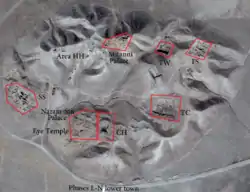
Soundings were conducted in 1930 by Antoine Poidebard although little was published.[171][172] After a survey of the area in 1934, Tell Brak was excavated for three seasons by the British archaeologist Sir Max Mallowan, husband of Agatha Christie, in 1937 and 1938.[173] The artifacts from Mallowan's excavations are now preserved in the Ashmolean Museum, National Museum of Aleppo and the British Museum's collection;[174] the latter contain the Tell Brak Head dating to c. 3500–3300 BC.[175][176] Two small cuneiform tablets were found and a half dozen fragments, all in the Akkadian period script.[177]
A team from the Institute of Archaeology of the University of London, led by David and Joan Oates, worked in the tell for 14 seasons between 1976 and 1993.[178][179] Finds included several Uruk Period numerical tablets and a number of cuneiform tablets and inscriptions.[180][181][182] After 1993, excavations were conducted by a number of field directors under the general guidance of David (until 2004) and Joan Oates. Those directors included Roger Matthews (in 1994–1996), for the McDonald Institute for Archaeological Research of the University of Cambridge; Geoff Emberling (in 1998–2002) and Helen McDonald (in 2000–2004), for the British Institute for the Study of Iraq and the Metropolitan Museum of Art. Finds included a large cache of carnelian, gold, silver, and lapis lazuli beads, late 3rd millennium arrowheads, stone maceheads, a range of ceramic wares, and an alabaster statuette of a seated bear.[183][184][185][186][29][187]
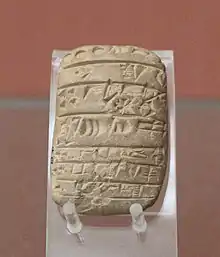
In 2006, Augusta McMahon became field director, also sponsored by the British Institute for the Study of Iraq.[72] A regional archaeological field survey in a 20 km (12 mi) radius around Brak was supervised by Henry T. Wright (in 2002–2005).[188] The survey data was combined with LANDSAT and 1960s era CORONA satellite images as well as historical photographs.[189] Many of the finds from the excavations at Tell Brak are on display in the Deir ez-Zor Museum.[190] The most recent excavations took place in the spring of 2011, but archaeological work is currently suspended due to the ongoing Syrian Civil War.[191]
A number of Proto-Literate clay tokens were found at the site, mainly in Uruk leveling fill but in one case in a stratified context. Most of the finds were pellets but also cones, discs, and ovioid bullae. In Late Uruk fill a number of large stone spheres and polished teardrops were found.[192]
Syrian Civil War
According to the Syrian authorities, the camp of archaeologists was looted, along with the tools and ceramics kept in it.[193] The site changed hands between the different combatants, mainly the Kurdish People's Protection Units and the Islamic State of Iraq and the Levant.[194] In early 2015, Tell Brak was taken by the Kurdish forces after light fighting with the Islamic State.[195]
See also
References
Informational notes
- Patzens are large rectangular bricks that come in different sizes.[19]
- The temple have multiple levels, the earliest two are named the red and grey levels respectively,[33] and they date to LC3.[34] The third level (the white level) is dated to period LC5 (c. 3200–3000 BC),[33][35] while the fourth and current visible one is named the "Latest Jemdet Nasr", and also dates to the late fourth millennium BC (LC5).[36] Excavations revealed two rebuilding following the "Latest Jemdet Nasr" building, and they date to the Early Dynastic period I.[36][37]
- Dated to the temple's grey level.[33]
- The temple is located in area TC, adjacent to the so called "Brak Oval" building.[47] It is dated to the Ninevite 5 period,[48] period J c. 2700 BC.[49] The temple consist of a single room with a mud brick altar,[48] and contained a cache of over 500 sealings.[50]
- The nature of the Akkadian early period is ambiguous, local texts do not reflect the reign of Sargon or his successors.[78] Two bowels bearing Rimush's inscription were discovered in the palace of his nephew Naram-Sin, however, they could have been diplomatic gifts to a local ruler.[79]
- Some of the building's bricks had Naram-Sin's name stamped on it.[86]
- Max Mallowan discovered a seal in 1947 and attributed it to Ur-Nammu of Ur; this led to the assumption that Ur controlled Tell-Brak.[95] However, the translation of the seal showed no sign of Ur-Nammu's name
- Harvey Weiss suggest the total abandonment of Nagar within fifty years following the Akkadians departure,[99] and attribute the event to a climatic disaster.[100] However, this view is controversial.[101]
- Previously, the Halafians were seen either as hill people who descended from the nearby mountains of southeastern Anatolia, or herdsmen from northern Iraq.[114] However, those views changed with the archaeology conducted by Peter Akkermans, which proved a continues indigenous origin of Halaf culture.[114]
- Belet is the feminine form of Bel, the east-Semitic title of a lord deity.[134] Belet-Nagar is translated as the lady of Nagar.[135]
- Belet-Nagar's worship was spread in wide areas, during year 8 of Amar-Sin's reign, a temple of Belet Nagar was erected in Ur.[139]
- Geoff Emberling argues for a southern forced take-over instead of a peaceful interaction.[42]
Citations
- Oates 2009, pp. 1.
- Bowden 2012, p. 48.
- Bertman 2005, p. 31.
- Max 1994, p. 29.
- Mallowan 1959, p. 24.
- Mallowan 1947, p. 10.
- Eidem 1998, p. 75.
- Oates, Oates & McDonald 1997b, p. 143.
- Bryce 2009, p. 492.
- Bryce 2009, p. 493.
- Oates & Oates 2001, p. 379.
- Buccellati 1999, p. 241.
- Matthews & Eidem 1993, p. 205.
- Ur, Karsgaard & Oates 2011, p. 4, 5.
- Matthews 1997, p. 129.
- Brooke 2014, p. 204.
- Forest 2009, p. 190.
- Ur, Karsgaard & Oates 2011, p. 4.
- Moorey 1999, p. 307.
- Yoffee 2015, p. 159.
- Oates 1987, p. 193–198.
- Glassner 2003, p. 31.
- Brooke 2014, p. 209.
- Peasnall 2002, p. 372.
- Demand 2011, p. 74.
- Ur, Karsgaard & Oates 2011, p. 6.
- Emberling et al. 2001, p. 31.
- Ur, Karsgaard & Oates 2011, p. 5.
- Emberling, Geoff, and Helen McDonald, "Excavations at Tell Brak 2001-2002: Preliminary Report", Iraq, vol. 65, pp. 1–75, 2003
- Ur, Karsgaard & Oates 2011, p. 7.
- Ferguson 2013, p. 220.
- McMahon, Augusta, et al., "Late Chalcolithic Mass Graves at Tell Brak, Syria, and Violent Conflict during the Growth of Early City-States", Journal of Field Archaeology, vol. 36, no. 3, pp. 201–20, 2011
- Akkermans & Schwartz 2003, p. 199.
- Oates & Oates 2002, p. 152.
- Emberling 2002, p. 87.
- Emberling 2002, p. 84.
- Matthews 1997, p. 171.
- Akkermans & Schwartz 2003, p. 198.
- Oates & Oates 2002, p. 151.
- Ur, Karsgaard & Oates 2011, p. 8.
- Averbeck 2003, p. 92.
- Algaze 2013, p. 84.
- Aubet 2013, p. 174.
- Demand 2011, p. 83.
- Ur, Karsgaard & Oates 2011, p. 9.
- Akkermans & Schwartz 2003, p. 200.
- Sołtysiak 2009, p. 36.
- Akkermans & Schwartz 2003, p. 216.
- Porter 2012, p. 186.
- Ur 2010, p. 411.
- Ristvet 2014, p. 217.
- Ur, Karsgaard & Oates 2011, p. 10.
- Kolinski 2007, p. 358.
- Emberling et al. 2001, p. 21, 31.
- Emberling et al. 2001, p. 31.
- Emberling et al. 2001, p. 33, 34.
- Eidem, Finkel & Bonechi 2001, p. 99.
- Eidem, Finkel & Bonechi 2001, p. 100.
- Eidem, Finkel & Bonechi 2001, p. 101.
- Ristvet 2014, p. 84.
- Sallaberger & Pruß 2015, p. 85.
- Ristvet 2014, p. 82.
- Ristvet 2014, p. 66.
- Lipiński 2001, p. 52.
- Bretschneider, Van Vyve & Leuven 2009, p. 5.
- Podany 2010, p. 57.
- Liverani 2013, p. 208.
- Biga 2014, p. 103.
- Podany 2010, p. 58.
- Archi, Alfonso; Biga, Maria Giovanna (2003). "A Victory over Mari and the Fall of Ebla". Journal of Cuneiform Studies. The American Schools of Oriental Research. 55: 1–44. doi:10.2307/3515951. ISSN 2325-6737. JSTOR 3515951. S2CID 164002885.
- McMahon 2013, p. 472.
- Bryce 2009, p. 135.
- Oates 2005, p. 7.
- Oates 2005, p. 10.
- Evans 2003, p. 228.
- Oates, Joan, Theya Molleson, and Arkadiusz Sołtysiak, "Equids and an acrobat: closure rituals at Tell Brak.", Antiquity 82.316, pp. 390-400, 2008
- Astour 2002, p. 163.
- McMahon 2013, p. 469.
- Matthews 1997, p. 2.
- Oates 2005, p. 11.
- Astour 2002, p. 162.
- Bryce 2009, p. 752.
- van Soldt 2010, p. 117.
- Leick 2002, p. 21.
- Weiss 2013, p. 374.
- Wossink 2009, p. 30.
- McDonald 1997, p. 109.
- Oates & Oates 2002, p. 146.
- Akkermans & Schwartz 2003, p. 279.
- Oates 2007, p. 171.
- Oates 2001, p. 170.
- Oates, Oates & McDonald 1997b, p. 141.
- Eidem, Finkel & Bonechi 2001, p. 102.
- Wossink 2009, p. 31.
- Eidem, Finkel & Bonechi 2001, p. 109.
- Weiss 1983, p. 49.
- Oates & Oates 2001, p. 129.
- Weiss 2013, p. 372.
- Weiss 2012, p. 5.
- Weiss 2012, p. 11.
- Akkermans & Schwartz 2003, p. 283.
- Ur, Karsgaard & Oates 2011, p. 12.
- Ur, Karsgaard & Oates 2011, p. 13.
- Liverani 2013, p. 226.
- Eidem 1998, p. 76.
- Kuz'mina 2007, p. 133.
- Burney 2004, p. 131.
- Oates 2005, p. 13.
- Ur, Karsgaard & Oates 2011, p. 14.
- Evans 2008, p. 195.
- Oates, Oates & McDonald 1997a, p. 14.
- Ur, Karsgaard & Oates 2011, p. 15.
- Ur, Karsgaard & Oates 2011, p. 1.
- Akkermans 2000, p. 43, 44.
- Akkermans & Schwartz 2003, p. 116.
- Jennings 2011, p. 73.
- Charles, Pessin & Hald 2010, p. 184.
- Campbell 2012, p. 429.
- Sallaberger 2007, p. 433.
- Archi 2009, p. 313.
- Archi 2002, p. 22.
- Biga 2014, p. 100.
- Matney 2012, p. 570.
- Guichard 2014, p. 152.
- Billington 2005, p. 121.
- Guichard 2014, p. 153.
- Charpin 2010, p. 94.
- Wilhelm 2008, p. 82.
- Jawad 1965, p. 73.
- Ulmer 2009, p. 286.
- Ristvet 2014, p. 76, 90.
- Emberling 2002, p. 85.
- Jawad 1965, p. 50.
- Bertman 2005, p. 117.
- Oates & Oates 2001, p. 381.
- Peyronel 2006, p. 398.
- Miller & Shipp 1996, p. 66.
- Astour 2002, p. 86.
- Archi 2002, p. 29.
- Akkermans 1989, p. 346.
- Oates 2007, p. 162.
- Collins 2003, p. 19.
- Porter 2012, p. 140.
- Porter 2012, p. 141.
- Michałowski 2003, p. 1.
- Peyronel 2006, p. 408.
- Matthews 1997, p. 136.
- McMahon 2012, p. 655.
- Peyronel 2006, p. 400.
- Oguchi, Hiromichi (2006). "The Date of The Beginning of Khabur Ware Period 3: Evidence from the Palace of Qarni-Lim at Tell Leilan" (PDF). Al-Rafidan. 27 (3): 45–59. Archived from the original (PDF) on 2012-03-20.
- Peyronel 2006, p. 402.
- Anthony 2007, p. 403.
- Garfinkle 2013, p. 101.
- Emberling 2015, p. 262.
- Ur 2009, p. 201.
- Ristvet 2014, p. 65, 61.
- Raccidi 2013, p. 184.
- Hamblin 2006, p. 304.
- Læssøe 1963, p. 82.
- Matthews 1997, p. 191.
- Bonatz 2014, p. 73.
- Ferguson 2013, p. 219.
- McIntosh 2005, p. 254.
- Jennings 2011, p. 72.
- Peyronel & Vacca 2013, p. 436.
- Kuz'mina 2007, p. 134.
- Bennett, E. Andrew; Weber, Jill; Bendhafer, Wejden; Chaplot, Sophie; Peters, Joris; Schwartz, Glenn M.; Grange, Thierry; Geigl, Eva-Maria (2022). "The genetic identity of the earliest human-made hybrid animals, the kungas of Syro-Mesopotamia". Science Advances. 8 (2): eabm0218. doi:10.1126/sciadv.abm0218. PMC 8759742. PMID 35030024. S2CID 245963400.
- Liverani 2013, p. 232.
- Oates 2005, p. 6.
- Ur 2009, p. 200.
- Poidebard, A., 1930. Statue trouvee a Tell Brak, Syria II, 360-4.
- Poidebard, A., I934. La Trace de Rome, Paris.
- Oates 1982, p. 62.
- Matthews 1997, p. 217.
- Collon 1995, p. 48.
- LaSor 1988, p. 689.
- Gadd, C. J., "Tablets from Chagar Bazar and Tall Brak, 1937-38", Iraq, vol. 7, pp. 22–66, 1940
- Oates, Joan, "Excavations at Tell Brak 1992–93", Iraq 55, pp. 155-199, 1993
- Oates, Joan, and David Oates., "Tell Brak: A Stratigraphic Summary, 1976-1993", Iraq, vol. 56, pp. 167–76, 1994
- Finkel, Irving L., "Inscriptions from Tell Brak 1984", Iraq, vol. 47, pp. 187–201, 1985
- Finkel, Irving L., "Inscriptions from Tell Brak 1985", Iraq, vol. 50, pp. 83–86, 1988
- N. J. J. Illingworth, "Inscriptions from Tell Brak 1986", Iraq, vol. 50, pp. 87–108, 1988
- R. J. Matthews, et al., "Excavations at Tell Brak, 1994", Iraq, vol. 56, pp. 177–94, 1994
- R. J. Matthews., "Excavations at Tell Brak, 1995", Iraq, vol. 57, pp. 87–111, 1995
- R. J. Matthews, "Excavations at Tell Brak, 1996", Iraq, vol. 58, pp. 65–77, 1996
- Emberling, Geoff and McDonald, Helen, "Recent finds from the northern Mesopotamian city of Tell Brak", Antiquity, vol. 76, pp. 949-950, 2002
- Eiland, Murray (2003). "Ceramics and Society". In Matthews, Roger (ed.). Excavations at Tell Brak. Vol. 4: Exploring an Upper Mesopotamian regional centre, 1994–1996. British School of Archaeology in Iraq.
- McMahon et al. 2007, p. 145.
- Oates 2009, pp. 28.
- Matthews 1997, p. v.
- Bowden 2012, p. 51.
- Jasim, Sabah Abboud, and Joan Oates, "Early Tokens and Tablets in Mesopotamia: New Information from Tell Abada and Tell Brak", World Archaeology, vol. 17, no. 3, pp. 348–62, 1986
- Elger 2014.
- Perry 2014.
- Sommerville 2015.
Bibliography
- Akkermans, Peter M. M. G. (1989). "Tradition and Social Change in Northern Mesopotamia During the Later Fifth and Fourth Millennium BC". In Henrickson, Elizabeth F.; Thuesen, Ingolf (eds.). Upon this Foundation: The 'Ubaid Reconsidered. Proceedings from the 'Ubaid Symposium, Elsinore, May 30th-June 1st 1988. Carsten Niebuhr Institute Publications. Vol. 10. Museum Tusculanum Press. ISBN 978-87-7289-070-8. ISSN 0902-5499.
- Akkermans, Peter M. M. G. (2000). "Old and New Perspectives on the Origins of the Halaf Culture". In Rouault, Olivier; Wäfler, Markus (eds.). La Djéziré et l'Euphrate syriens de la protohistoire à la fin du second millénaire av. J.-C.: Tendances dans l'interprétation historique des données nouvelles. Subartu (SUBART). Vol. 7. Brepols Publishers. ISBN 978-2-503-51063-7.
- Akkermans, Peter M. M. G.; Schwartz, Glenn M. (2003). The Archaeology of Syria: From Complex Hunter-Gatherers to Early Urban Societies (c.16,000-300 BC). Cambridge University Press. ISBN 978-0-521-79666-8.
- Algaze, Guillermo (2013). "The End of Prehistory and The Uruk Period". In Crawford, Harriet (ed.). The Sumerian World. Routledge. ISBN 978-1-136-21912-2.
- Anthony, David W. (2007). The Horse, the Wheel, and Language: How Bronze-Age Riders from the Eurasian Steppes Shaped the Modern World. Princeton University Press. ISBN 978-1-4008-3110-4.
- Archi, Alfonso (2002). "Formation of the West Hurrian Pantheon: The Case Of Ishara". In Yener, K. Aslihan; Hoffner, Harry A.; Dhesi, Simrit (eds.). Recent Developments in Hittite Archaeology and History. Eisenbrauns. ISBN 978-1-57506-053-8.
- Archi, Alfonso (2009) [2008]. "Eblaite". In Brown, Keith; Ogilvie, Sarah (eds.). Concise Encyclopedia of Languages of the World. Elsevier. ISBN 978-0-08-087775-4.
- Astour, Michael C. (2002). "A Reconstruction of the History of Ebla (Part 2)". In Gordon, Cyrus Herzl; Rendsburg, Gary (eds.). Eblaitica: Essays on the Ebla Archives and Eblaite Language. Vol. 4. Eisenbrauns. ISBN 978-1-57506-060-6.
- Aubet, Maria Eugenia (2013). Commerce and Colonization in the Ancient Near East. Translated by Turton, Mary. Cambridge University Press. ISBN 978-0-521-51417-0.
- Averbeck, Richard E. (2003) [2002]. "Sumer, the Bible, and Comparative Method: Historiography and Temple Building". In Chavalas, Mark W.; Younger. Jr, K. Lawson (eds.). Mesopotamia and the Bible: Comparative Explorations. T&T Clark International. ISBN 978-0-567-56900-4.
- Bertman, Stephen (2005) [2003]. Handbook to Life in Ancient Mesopotamia. Oxford University Press. ISBN 978-0-19-518364-1.
- Biga, Maria Giovanna (2014). "Inherited Space – Third Millennium Political and Cultural Landscape". In Cancik-Kirschbaum, Eva; Brisch, Nicole; Eidem, Jesper (eds.). Constituent, Confederate, and Conquered Space: The Emergence of the Mittani State. Walter de Gruyter. ISBN 978-3-11-026641-2.
- Billington, Clyde E. (2005). "Othniel, Cushan-Rishathaim, and the Date of the Exodus". In Carnagey Sr., Glenn A.; Carnagey Jr., Glenn; Schoville, Keith N. (eds.). Beyond the Jordan: Studies in Honor of W. Harold Mare. Wipf & Stock Publishers. ISBN 978-1-59752-069-0.
- Bonatz, Dominik (2014). "Tell Fekheriye in the Late Bronze Age: Archaeological Investigations into the Structures of Political Governance in the Upper Mesopotamian Piedmont". In Bonatz, Dominik (ed.). The Archaeology of Political Spaces: The Upper Mesopotamian Piedmont in the Second Millennium BCE. Topoi – Berlin Studies of the Ancient World. Vol. 12. Walter de Gruyter. ISBN 978-3-11-026640-5.
- Bowden, James (2012). "The Voices of Tell Brak". Archaeological Diggings. Hornsby, N.S.W.; Down D.K. 19 (4). ISSN 1322-6525. OCLC 47261199.
- Bretschneider, Joachim; Van Vyve, Anne-Sophie; Leuven, Greta Jans (2009). "War of the lords, The Battle of Chronology: Trying to Recognize Historical Iconography in the 3rd Millennium Glyptic Art in seals of Ishqi-Mari and from Beydar". Ugarit-Forschungen. Ugarit-Verlag. 41. ISBN 978-3-86835-042-5.
- Brooke, John L. (2014). Climate Change and the Course of Global History: A Rough Journey. Cambridge University Press. ISBN 978-0-521-87164-8.
- Bryce, Trevor (2009). The Routledge Handbook of the Peoples and Places of Ancient Western Asia. Routledge. ISBN 978-1-134-15908-6.
- Buccellati, Giorgio (1999). "Urkesh and the Question of Early Hurrian Urbanism". In Hudson, Michael; Levine, Baruch (eds.). Urbanization and Land Ownership in the Ancient Near East. Peabody Museum Bulletin. Vol. 7. Harvard University Press. ISBN 978-0-87365-957-4.
- Burney, Charles (2004). Historical Dictionary of the Hittites. Historical Dictionaries of Ancient Civilizations and Historical Eras. Vol. 14. Scarecrow Press. ISBN 978-0-8108-6564-8.
- Campbell, Stuart (2012). "Northern Mesopotamia". In Potts, Daniel T. (ed.). A Companion to the Archaeology of the Ancient Near East. Vol. 1. John Wiley & Sons. ISBN 978-1-4443-6077-6.
- Charles, Michael; Pessin, Hugues; Hald, Mette Marie (2010). "Tolerating Change at Late Chalcolithic Tell Brak: Responses of an Early Urban Society to an Uncertain Climate". Environmental Archaeology. Maney Publishing. 15 (2): 183–198. doi:10.1179/146141010X12640787648892. ISSN 1749-6314. S2CID 128896094.
- Charpin, Dominique (2010) [2008]. Reading and Writing in Babylon. Translated by Todd, Jane Marie. Harvard University Press. ISBN 978-0-674-04968-0.
- Collins, Paul (2003). "Frieze From a Temple Altar". In Aruz, Joan; Wallenfels, Ronald (eds.). Art of the First Cities: The Third Millennium B.C. from the Mediterranean to the Indus. Metropolitan Museum of Art. ISBN 978-1-58839-043-1.
- Collon, Dominique (1995). Ancient Near Eastern Art. University of California Press. ISBN 978-0-520-20307-5.
- Demand, Nancy H. (2011). The Mediterranean Context of Early Greek History. John Wiley & Sons. ISBN 978-1-4443-4234-5.
- Eidem, Jesper; Finkel, Irving; Bonechi, Marco (2001). "The Third-millennium Inscriptions". In Oates, David; Oates, Joan; McDonald, Helen (eds.). Excavations at Tell Brak, Volume 2: Nagar in the third millennium BC. McDonald Institute for Archaeological Research and the British School of Archaeology in Iraq. ISBN 978-0-9519420-9-3.
- Elger, Katrin (August 4, 2014). "Monuments Men: The Quest to Save Syria's History". Spiegel Online. Retrieved December 26, 2016.
- Emberling, Geoff; McDonald, Helen; Charles, Michael; Green, Walton A.; Hald, Mette Marie; Weber, Jill; Wright, Henry T. (2001). "Excavations at Tell Brak 2000: Preliminary report". IRAQ. Cambridge University Press - On Behalf of The British Institute for the Study of Iraq (Gertrude Bell Memorial). 63: 21–54. doi:10.2307/4200500. ISSN 0021-0889. JSTOR 4200500. S2CID 130179245.
- Emberling, Geoff (2002). "Political Control in an Early State: The Eye Temple and the Uruk Expansion in Northern Mesopotamia". In Al-Gailani Werr, Lamia; Curtis, John; Martin, Harriet; McMahon, Augusta; Oates, Joan; Reade, Julian (eds.). Of Pots and Plans: Papers on the Archaeology and History of Mesopotamia and Syria presented to David Oates in Honour of his 75th Birthday. NABU Booksellers. ISBN 978-1-897750-62-9.
- Emberling, Geoff (2015). "Mesopotamian Cities and Urban Process, 3500–1600 BCE". In Yoffee, Norman (ed.). The Cambridge World History, Volume 3: Early Cities in Comparative Perspective 4000BCE-1200CE. Cambridge University Press. ISBN 978-0-521-19008-4.
- Evans, Jean M. (2003). "Tell Brak in the Akkadian Period". In Aruz, Joan; Wallenfels, Ronald (eds.). Art of the First Cities: The Third Millennium B.C. from the Mediterranean to the Indus. Metropolitan Museum of Art. ISBN 978-1-58839-043-1.
- Evans, Jean M. (2008). "The Mitanni State". In Aruz, Joan; Benzel, Kim; Evans, Jean M. (eds.). Beyond Babylon: Art, Trade, and Diplomacy in the Second Millennium B.C.. Metropolitan Museum of Art. ISBN 978-1-58839-295-4.
- Ferguson, R. Brian (2013). "Prehistory of War and Peace in Europe and the Near East". In Fry, Douglas P. (ed.). War, Peace, and Human Nature: The Convergence of Evolutionary and Cultural Views. Oxford University Press. ISBN 978-0-19-985900-9.
- Forest, Jean-Daniel (2009). "The State: The Process of State Formation as Seen from Mesopotamia". In Pollock, Susan; Bernbeck, Reinhard (eds.). Archaeologies of the Middle East: Critical Perspectives. John Wiley & Sons. ISBN 978-1-4051-3723-2.
- Garfinkle, Steven J. (2013). "Ancient Near Eastern City States". In Bang, Peter Fibiger; Scheidel, Walter (eds.). The Oxford Handbook of the State in the Ancient Near East and Mediterranean. Oxford University Press. ISBN 978-0-19-518831-8.
- Glassner, Jean-Jacques (2003) [2000]. The Invention of Cuneiform: Writing in Sumer. Translated by Bahrani, Zainab; Van de Mieroop, Marc. Johns Hopkins University Press. ISBN 978-0-8018-7389-8.
- Guichard, Michaël (2014). "Political Space – Local Political Structures in Northern Syria. The Case of the Country of Ida-Maras in the Eighteenth Century BC". In Cancik-Kirschbaum, Eva; Brisch, Nicole; Eidem, Jesper (eds.). Constituent, Confederate, and Conquered Space: The Emergence of the Mittani State. Walter de Gruyter. ISBN 978-3-11-026641-2.
- Hamblin, William J. (2006). Warfare in the Ancient Near East to 1600 BC. Routledge. ISBN 978-1-134-52062-6.
- Jawad, Abdul Jalil (1965). The Advent of the Era of Townships in Northern Mesopotamia. Brill. OCLC 432527.
- Jennings, Justin (2011). Globalizations and the Ancient World. Cambridge University Press. ISBN 978-1-139-49292-8.
- Kolinski, Rafal (2007). "The Upper Khabur Region in the Second Part of the Third Millennium BC". Altorientalische Forschungen. Walter de Gruyter. 34 (1–2). doi:10.1524/aofo.2007.34.12.346. ISSN 2196-6761. S2CID 201100256.
- Eidem, Eidem (1998). "Nagar". In Edzard, Dietz-Otto (ed.). Nab - Nuzi. ISBN 978-3-11-017296-6.
{{cite book}}:|journal=ignored (help) - Kuz'mina, Elena E. (2007). Mallory, James Patrick (ed.). The Origin of the Indo-Iranians. Translated by Pitina, Svetlana; Prudovsky, P. Brill. ISBN 978-90-04-16054-5.
- Læssøe, Jørgen (1963). People of Ancient Assyria: Their Inscriptions and Correspondence. Translated by Leigh-Browne, Frederick Sebastian. Routledge. OCLC 2086093.
- LaSor, William Sanford (1988). "Syria". In Bromiley, Geoffrey W.; Harrison, Everett F.; Harrison, Roland K.; LaSor, William Sanford (eds.). The International Standard Bible Encyclopedia. Vol. 4 (fully revised ed.). Wm. B. Eerdmans Publishing. ISBN 978-0-8028-3784-4.
- Leick, Gwendolyn (2002). Who's Who in the Ancient Near East. Routledge. ISBN 978-1-134-78796-8.
- Lipiński, Edward (2001). Semitic Languages: Outline of a Comparative Grammar. Orientalia Lovaniensia Analecta. Vol. 80 (2 ed.). Peeters Publishers & Department of Oriental Studies, Leuven. ISBN 978-90-429-0815-4. ISSN 0777-978X.
- Liverani, Mario (2013). The Ancient Near East: History, Society and Economy. Routledge. ISBN 978-1-134-75084-9.
- Mallowan, Max Edgar Lucien (1947). "Part I. Brak and Chagar Bazar: Their Contribution to Archaeology". IRAQ. Cambridge University Press - On Behalf of The British Institute for the Study of Iraq (Gertrude Bell Memorial). 9 (1): 10–47. doi:10.1017/S002108890000615X. ISSN 0021-0889. S2CID 132151508.
- Mallowan, Max Edgar Lucien (1959). Twenty-Five Years of Mesopotamian Discovery (1932–1956). British School of Archaeology in Iraq. OCLC 928965616.
- Matney, Timothy (2012). "Northern Mesopotamia". In Potts, Daniel T. (ed.). A Companion to the Archaeology of the Ancient Near East. Vol. 1. John Wiley & Sons. ISBN 978-1-4443-6077-6.
- Matthews, Donald; Eidem, Jesper (1993). "Tell Brak and Nagar". IRAQ. Cambridge University Press - On Behalf of The British Institute for the Study of Iraq (Gertrude Bell Memorial). 55: 201–207. doi:10.2307/4200376. ISSN 0021-0889. JSTOR 4200376. S2CID 191403234.
- Matthews, Donald M. (1997). The Early Glyptic of Tell Brak: Cylinder Seals of Third Millennium Syria. Orbis Biblicus et Orientalis- Series Archaeologica. Vol. 15. University Press Fribourg Switzerland. ISBN 978-3-525-53896-8.
- Max, Gerald E. (1994). "Ancient Near East". In Wiegand, Wayne A.; Davis. Jr, Donald G. (eds.). Encyclopedia of Library History. Garland Publishing. ISBN 978-1-135-78757-8.
- McDonald, Helen (1997). "The Beads". In Oates, David; Oates, Joan; McDonald, Helen (eds.). Excavations at Tell Brak, Volume 1: The Mitanni and Old Babylonian periods. McDonald Institute for Archaeological Research and the British School of Archaeology in Iraq. ISBN 978-0-9519420-5-5.
- McIntosh, Jane (2005). Ancient Mesopotamia: New Perspectives. ABC-CLIO. ISBN 978-1-57607-965-2.
- McMahon, Augusta; Oates, Joan; al-Quntar, Salam; Colantoni, Carlo; Hald, Mette Marie; Karsgaard, Philip; Khalidi, Lamya; Sołtysiak, Arkadiusz; Stone, Adam; Weber, Jill (2007). "Excavations at Tell Brak 2006–2007". IRAQ. Cambridge University Press - On Behalf of The British Institute for the Study of Iraq (Gertrude Bell Memorial). 69: 145–171. doi:10.1017/S0021088900001091. ISSN 0021-0889. S2CID 131779390.
- McMahon, Augusta (2012). "The Akkadian Period: Empire, Environment, and Imagination". In Potts, Daniel T. (ed.). A Companion to the Archaeology of the Ancient Near East. Vol. 1. John Wiley & Sons. ISBN 978-1-4443-6077-6.
- McMahon, Augusta (2013). "North Mesopotamia in the Third Millennium BC". In Crawford, Harriet (ed.). The Sumerian World. Routledge. ISBN 978-1-136-21912-2.
- Michałowski, Piotr (2003). "An Early Dynastic Tablet of ED Lu A From Tell Brak (Nagar)" (PDF). Cuneiform Digital Library Journal. Cuneiform Digital Library Initiative. 3. ISSN 1540-8779.
- Miller, Douglas B.; Shipp, R. Mark (1996) [1993]. An Akkadian Handbook: Paradigms, Helps, Glossary, Logograms, and Sign List. Eisenbrauns. ISBN 978-0-931464-86-7.
- Moorey, Peter Roger Stuart (1999) [1994]. Ancient Mesopotamian Materials and Industries: The Archaeological Evidence. Eisenbrauns. ISBN 978-1-57506-042-2.
- Oates, David (1982). "Tell Brak". In Curtis, John (ed.). Fifty Years of Mesopotamian Discovery, the Work of the British School of Archaeology in Iraq, 1932–1982. British School of Archaeology in Iraq. ISBN 978-0-903472-05-0.
- Oates, David; Oates, Joan; McDonald, Helen, eds. (1997a). "The Excavations". Excavations at Tell Brak, Volume 1: The Mitanni and Old Babylonian periods. McDonald Institute for Archaeological Research and the British School of Archaeology in Iraq. ISBN 978-0-9519420-5-5.
- Oates, David; Oates, Joan; McDonald, Helen, eds. (1997b). "Historical Commentary". Excavations at Tell Brak, Volume 1: The Mitanni and Old Babylonian periods. McDonald Institute for Archaeological Research and the British School of Archaeology in Iraq. ISBN 978-0-9519420-5-5.
- Oates, David; Oates, Joan (2001a). "Archaeological Reconstruction and Historical Commentary". In Oates, David; Oates, Joan; McDonald, Helen (eds.). Excavations at Tell Brak, Volume 2: Nagar in the third millennium BC. McDonald Institute for Archaeological Research and the British School of Archaeology in Iraq. ISBN 978-0-9519420-9-3.
- Oates, David; Oates, Joan (2001b). "Tell Brak". In Trümpler, Charlotte (ed.). Agatha Christie and Archaeology. British Museum Press. ISBN 978-0-7141-1148-3.
- Oates, David; Oates, Joan (2002). "The Reattribution of Middle Uruk Materials at Tell Brak". In Ehrenberg, Erica (ed.). Leaving No Stones Unturned: Essays on the Ancient Near East and Egypt in Honor of Donald P. Hansen. Eisenbrauns. ISBN 978-1-57506-055-2.
- Oates, Joan (1987). "A Note on 'Ubaid and Mitanni Pottery from Tell Brak". IRAQ. Cambridge University Press - On Behalf of The British Institute for the Study of Iraq (Gertrude Bell Memorial). 49: 193–198. doi:10.2307/4200272. ISSN 0021-0889. JSTOR 4200272. S2CID 162275365.
- Oates, Joan (2001). "The Third-millennium Pottery". In Oates, David; Oates, Joan; McDonald, Helen (eds.). Excavations at Tell Brak, Volume 2: Nagar in the third millennium BC. McDonald Institute for Archaeological Research and the British School of Archaeology in Iraq. ISBN 978-0-9519420-9-3.
- Oates, Joan (2005). "Archaeology in Mesopotamia: Digging Deeper at Tell Brak". 2004 Lectures (PDF). Proceedings of the British Academy. Vol. 131. Oxford University Press. ISBN 978-0-19-726351-8. ISSN 0068-1202.
- Oates, Joan (2007). "Monumental Public Architecture in Late Chakolithic and Bronze Age Mesopotamia, with particular reference to Tell Brak and Tell al Rimah". In Bretschneider, Joachim; Driessen, Jan; van Lerberghe, Karel (eds.). Power and Architecture: Monumental Public Architecture in the Bronze Age Near East and Aegean. Orientalia Lovaniensia Analecta. Vol. 156. Peeters Publishers & Department of Oriental Studies, Leuven. ISBN 978-90-429-1831-3. ISSN 0777-978X.
- Peasnall, Brian (2002). "Ubaid". In Peregrine, Peter N.; Ember, Melvin (eds.). Encyclopedia of Prehistory, Volume 8: South and Southwest Asia. Kluwer Academic/Plenum Publishers. ISBN 978-0-306-46262-7.
- Perry, Tom (February 22, 2014). "Syrian Kurds Take Town From Islamists: Watchdog". Reuters. Retrieved December 26, 2016.
- Peyronel, Luca (2006). "Excavations at Tell Brak, Vol. 2: Nagar in the Third Millennium BC". Orientalia. Pontificium Institutum Biblicum. 75 (4). OCLC 557711946.
- Peyronel, Luca; Vacca, Agnese (2013). "Natural Resources, Technology and Manufacture Processes at Ebla. A Preliminary Assessment". In Matthiae, Paolo; Marchetti, Nicolò (eds.). Ebla and its Landscape: Early State Formation in the Ancient Near East. Left Coast Press. ISBN 978-1-61132-228-6.
- Podany, Amanda H. (2010). Brotherhood of Kings: How International Relations Shaped the Ancient Near East. Oxford University Press. ISBN 978-0-19-979875-9.
- Porter, Anne (2012). Mobile Pastoralism and the Formation of Near Eastern Civilizations: Weaving Together Society. Cambridge University Press. ISBN 978-0-521-76443-8.
- Raccidi, Mattia (2013). "Wagons and Carts in the 3rd Millennium BC. Syrian Jazirah: A Study Through the Documentation". In Veldmeijer, André J.; Ikram, Salima (eds.). Chasing Chariots: Proceedings of the first international chariot conference (Cairo 2012). Sidestone Press. ISBN 978-90-8890-209-3.
- Ristvet, Lauren (2014). Ritual, Performance, and Politics in the Ancient Near East. Cambridge University Press. ISBN 978-1-316-19503-1.
- Sallaberger, Walther (2007). "From Urban Culture to Nomadism : A History of Upper Mesopotamia in the Late Third Millennium". In Kuzucuoğlu, Catherine; Marro, Catherine (eds.). Sociétés Humaines et Changement Climatique à la Fin du Troisième Millénaire: Une Crise a-t-elle eu Lieu en Haute Mésopotamie?, Actes du Colloque de Lyon (5-8 décembre 2005). ISBN 978-2-906053-94-6.
{{cite book}}:|journal=ignored (help) - Sallaberger, Walther; Pruß, Alexander (2015). "Home and Work in Early Bronze Age Mesopotamia:"Ration Lists" and "Private Houses" at Tell Beydar/Nabada". In Steinkeller, Piotr; Hudson, Michael (eds.). Labor in the Ancient World. International Scholars Conference on Ancient Near Eastern Economics. Vol. 5. Islet Press. ISBN 978-3-981-48423-6.
- Sołtysiak, Arkadiusz (2009). "Short Fieldwork Report: Tell Brak (Syria), Seasons 1984–2009". Bioarchaeology of the Near East. Department of Bioarchaeology, Institute of Archaeology, University of Warsaw. 3. ISSN 1898-9403.
- Sommerville, Quentin (March 15, 2015). "Volunteering with the Kurds to fight IS". BBC. Retrieved December 26, 2016.
- Ulmer, Rivka (2009). Egyptian Cultural Icons in Midrash. Studia Judaica: Forschungen zur Wissenschaft des Judentums. Vol. 52. Walter de Gruyter. doi:10.1515/9783110223934. ISBN 978-3-11-022392-7. ISSN 0585-5306.
- Ur, Jason (2009). "Emergent Landscapes of Movement in Early Bronze Age Northern Mesopotamia". In Snead, James E.; Erickson, Clark L.; Darling, J. Andrew (eds.). Landscapes of Movement: Trails, Paths, and Roads in Anthropological Perspective. Penn Museum International Research Conferences. Vol. 1. University of Pennsylvania Press. ISBN 978-1-934536-53-7.
- Ur, Jason Alik (2010). "Cycles of Civilization in Northern Mesopotamia, 4400–2000 BC". Journal of Archaeological Research. Springer. 18 (4): 387–431. doi:10.1007/s10814-010-9041-y. ISSN 1059-0161. S2CID 145000732.
- Ur, Jason; Karsgaard, Philip; Oates, Joan (2011). "The Spatial Dimensions of Early Mesopotamian Urbanism: The Tell Brak Suburban Survey, 2003–2006". IRAQ. Cambridge University Press - On Behalf of The British Institute for the Study of Iraq (Gertrude Bell Memorial). 73: 1–19. doi:10.1017/S0021088900000061. ISSN 0021-0889. S2CID 33518626.
- van Soldt, Wilfred H (2010). "The Adaptation of the Cuneiform Script to Foreign Languages". In de Voogt, Alexander J.; Finkel, Irving L. (eds.). The Idea of Writing: Play and Complexity. Brill. ISBN 978-90-04-17446-7.
- Weiss, Harvey (1983). "Excavations at Tell Leilan and the Origins of North Mesopotamian cities in the Third Millennium B.C.". Paléorient. Association Paléorient. 9 (2): 39–52. doi:10.3406/paleo.1983.4340. ISSN 0153-9345.
- Weiss, Harvey (2012). "Quantifying Collapse: The Late Third Millennium Khabur Plains". In Weiss, Harvey (ed.). Seven Generations Since the Fall of Akkad. Studia Chaburensia. Vol. 3. Harrassowitz Verlag. ISBN 978-3-447-06823-9. ISSN 1869-845X.
- Weiss, Harvey (2013). "The Northern Levant During the Intermediate Bronze Age: Altered Trajectories". In Steiner, Margreet L.; Killebrew, Ann E. (eds.). The Oxford Handbook of the Archaeology of the Levant: c. 8000-332 BCE. Oxford University Press. ISBN 978-0-19-166255-3.
- Wilhelm, Gernot (2008). "Hurrian". In Woodard, Roger D. (ed.). The Ancient Languages of Asia Minor. Cambridge University Press. ISBN 978-1-139-46933-3.
- Wossink, Arne (2009). Challenging Climate Change: Competition and Cooperation Among Pastoralists and Agriculturalists in Northern Mesopotamia (c. 3000–1600 BC). Sidestone Press. ISBN 978-90-8890-031-0.
- Yoffee, Norman (2015) [2012]. "Deep Pasts Interconnections and Comparative History in the Ancient World". In Northrop, Douglas (ed.). A Companion to World History. John Wiley & Sons. ISBN 978-1-118-30547-8.
Further reading
General
- Biga, M. G., "The Marriage of Eblaite Princess Tagrisˇ-Damu with a Son of Nagar’s King", Subartu, IV, 2, pp. 17–22, 1998
- Oates, Joan, and David Oates, "An open gate: Cities of the fourth millennium BC (Tell Brak 1997)." Cambridge Archaeological Journal 7.2, pp. 287-297, 1997
- Oates, David; Oates, Joan (1989). "Akkadian Buildings at Tell Brak". Iraq. 51: 193–211. doi:10.2307/4200303. ISSN 0021-0889. JSTOR 4200303. S2CID 162449952.
- Oates, Joan (1982j). "Some Late Early Dynastic III Pottery from Tell Brak". Iraq. 44 (2): 205–219. doi:10.2307/4200163. ISSN 0021-0889. JSTOR 4200163. S2CID 163191059.
- Wilhelm, G. (1991). "A Hurrian Letter from Tell Brak" (PDF). Iraq. 53: 159–168. doi:10.2307/4200345. ISSN 0021-0889. JSTOR 4200345. S2CID 162464364.
- Ur, Jason A., "Urban form at Tell Brak across three millennia.", in Preludes to Urbanism: Studies in the Late Chalcolithic of Mesopotamia in Honour of Joan Oates, Archaeopress, Oxford, 2014
Excavation Related
- Ambers, J., "Radiocarbon results from Tell Brak", Iraq 55, pp. 198-199, 1993
- Bowman, S. G. E., and J. C. Ambers, "Radiocarbon Dates for Tell Brak, 1987", Iraq, vol. 51, pp. 213–15, 1989
- Clutton-Brock, Juliet, "A Dog and a Donkey Excavated at Tell Brak", Iraq, vol. 51, pp. 217–24, 1989
- Clutton-Brock, Juliet, and Sophie Davies, "More Donkeys from Tell Brak", Iraq, vol. 55, pp. 209–21, 1993
- Emberling, Geoff, et al., "Excavations at Tell Brak 1998: preliminary report.", Iraq, pp. 1-41, 1991
- Fielden, Kate, "Tell Brak 1976: the pottery.", Iraq 39.2, pp. 245-255, 1977
- Fielden, Kate, "A Late Uruk pottery group from Tell Brak, 1978", Iraq 43, pp. 157-166, 1981
- Mallowan, M. E. L., "Excavations at Brak and Chagar Bazar", Iraq, vol. 9, pp. 1-259, 1947
- Roger Mathews, "Excavations at Tell Brak 4: Exploring an Upper Mesopotamian Regional Centre, 1994-1996", McDonald Institute Monographs, McDonald Institute for Archaeological Research, July 15 2003 ISBN 978-1902937168
- Oates, David, "The Excavations at Tell Brak, 1976.", Iraq 39.2, pp. 233-244, 1977
- Oates, David, "Excavations at Tell Brak, 1978–81.", Iraq 44.2, pp. 187-204, 1982
- Oates, David, "Excavations at Tell Brak, 1983–84.", Iraq 47, pp. 159-173, 1985
- Oates, David, "Excavations at tell brak 1985–86.", Iraq 49, pp. 175-191, 1987
- Oates, David, and Joan Oates, "Excavations at Tell Brak 1990-91.", Iraq 53, pp. 127-145, 1991
- Oates, Joan, "Excavations at Tell Brak, NE Syria, 1992.", Cambridge Archaeological Journal 3.1, pp. 137-140, 1993
External links
- Piotr Michałowski, "Bibliographical information (Tell Brak & related matters)
- SciAm: Ancient Squatters May Have Been the World's First Suburbanites
- Death and the City: Recent Work at Tell Brak, Syra - Oriental Institute video/audio lecture
- White-Levy Brak publication project
- BISI Webinar: Prof Augusta McMahon on 'From Tell Brak to Lagash' - Augusta McMahon - Feb 21, 2022
- Archaeology breakthrough after spy satellite images unveiled world's ‘first city’ - Express - Mar 8, 2022


